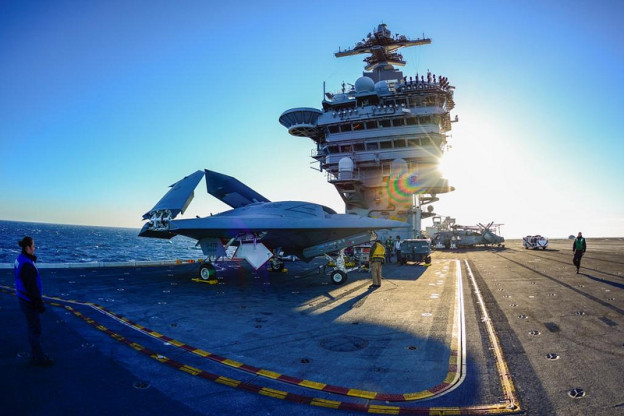
The requirements for the Navy’s Unmanned Carrier Launched Airborne Surveillance and Strike (UCLASS) aircraft program might not be settled just yet.
Rear Adm. Mat Winter, Naval Air Systems Command’s (NAVAIR) program executive officer for unmanned aviation and strike weapons, had told USNI News on Nov. 10 that the top-level requirements for the new aircraft are, “solid.”
But — according to several sources — there is still an ongoing and hotly contested debate underway between various factions within the Pentagon as to whether the UCLASS will be focused on the penetrating strike mission versus the permissive environment intelligence, surveillance and reconnaissance (ISR) role.
The Pentagon is taking another hard look as to whether or not it has struck the right balance for the UCLASS’s capabilities for characteristics such as range, stealth and payload along with what potential missions the aircraft might be required to undertake.
“There is a growing sentiment that just another ISR aircraft is not necessarily the way to go,” a source familiar with the program told USNI News. But cautions, “I would take any public announcement with a big grain of salt right now until these issues are resolved.”
The debate goes deeper than merely the fate of the UCLASS program, the real battle is over the shape of the future carrier air wing and if the service will ever develop another manned fighter to replace the Boeing F/A-18E/F Super Hornet. “There are huge equities involved for the aviation community,” the source said.
Meanwhile, Congressional and Navy sources said they have not seen anything that would indicate substantial changes to the UCLASS requirements are forthcoming. What changes are anticipated are expected to be merely cosmetic in nature.
The continuing debate is the reason for the Navy’s frequent delays in releasing the UCLASS draft request for proposals (RFP).
“Frankly, having various Admirals saying ‘well, it’s going to do this and it’s going to do that’ now is premature,” the source said. “We don’t know that until the [key performance parameters] are resolved. Right now it’s more opinion than fact based.”
The draft RFP is currently scheduled for a mid-December release with the final version anticipated for the second quarter of fiscal year 2014. A contact award is anticipated in the first quarter of fiscal year 2015, while the UCLASS early operational capability date is expected somewhere between 2019 and 2021. But that would depend upon the technical maturity of the design that is ultimately selected.
Mark Gunzinger, an airpower analyst at the Center for Strategic and Budgetary Assessments, said that if the Navy settles on a UCLASS requirement that calls for a basic ISR aircraft with little stealth capability, it might not be worth continuing with the program. “If the UCLASS is going to be little more than another ISR platform, it may be better just to skip it and proceed to a Naval UCAS—a naval unmanned combat air system,” he said.
Meanwhile, some in industry are calling for the Navy to take a “time-out” on the UCLASS program as the requirements debate continues unabated. “Given the ongoing requirements refinement while the PDR [preliminary design review] contracts are already underway, as well as the criticisms concerning the atypical acquisition plan, the Navy needs to take a time-out to re-plan and get it right,” said one industry source.
“This could include updating/refreshing the Analysis of Alternatives (AoA) to determine if UCLASS would really be the best or lowest cost solution to augment carrier-based aerial refueling capabilities that are currently performed by Super Hornets,” according to an industry source.
The Navy has been contemplating using the UCLASS as an aerial refueling platform to take-over some of the tanker role from the Boeing F/A-18E/F strike fighter. The Super Hornets are wearing out much faster than anticipated due to the high stresses that are imposed on the airframe during those missions.
The industry source suggested that if the Navy were to refresh the UCLASS AOA, the Lockheed Martin S-3B Viking and Bell-Boeing V-22 Osprey should be considered for the tanker role. There has already been some informal work done within the Navy on a proposal to return some retired S-3Bs to service for the aerial refueling mission.





